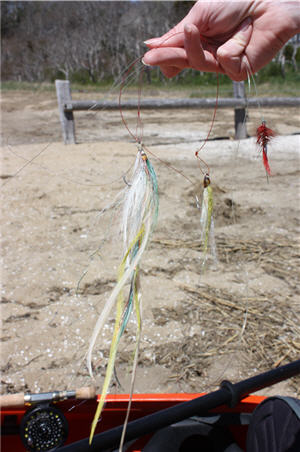
By Tom Keer for Take Me Fishing
Dropper rigs are standard operating procedures for trout bums, but they are relatively uncommon in the salt. That fact always surprises me, particularly because there are so many different types of bait in the water at all times. That point was illustrated last fall when a pod of big bluefish and striped bass pushed nine different types of bait on shore. Using a dropper rig helps anglers find what bait the fish want so they can get on with the catching.
Dropper rigs enable anglers to add multiple flies to their leader. It’s a simple process that comes when you’re already building a leader. Conventional fishermen can also add a fly  to their plug, stickbait, or crankbait. Need some convincing? Tony Stetzo caught a 73-pound striped bass that was the 1981 World Record on a fly dropper ahead of a plug.
to their plug, stickbait, or crankbait. Need some convincing? Tony Stetzo caught a 73-pound striped bass that was the 1981 World Record on a fly dropper ahead of a plug.
Here’s the easiest way to build a three-fly dropper rig.
1. Take a three foot section of 30-pound monofilament. Tie a Surgeon’s Loop in one end, and that end will connect your leader to your fly line loop.
2. Add a three foot section of 20-pound monofilament as a graduation. Connect the two with a Five-Turn Surgeon’s knot. Use plenty of material and leave a tag end that is about eight to ten inches long.
3. Add a three foot section of 10-pound monofilament as a tippet. Connect the two with a Five-Turn Surgeon’s knot. Use plenty of material and leave a tag end that is about eight to ten inches long.
Attach your fly to the tag ends with either an Improved Cinch Knot or Surgeon’s Loop, and be sure to tie it off of the back tag end which is the one that points away from your rod. You’ll get fewer breakoffs. Trim the remaining tag end.
I tie smaller flies that imitate silversides, clam worms, shrimp, or sandeels on the droppers. My point fly is always the largest one and imitates herring, alewives, or menhaden. If the large fly attracts a big fish, I have plenty of strength to put him in my kayak.
I love the simplicity of the design, particularly if I’m using heavier monofilament, fishing at night, or working with cold fingers during the early and late season chill. I favor stiffer leader materials so as to maintain a distance between the fly and the leader.
This season, don’t spend as much time trying to identify the baitfish in the ocean. Instead, twist up a few dropper rigs. The proof is in the pudding, and you’ll get more hook ups.
Tom Keer is an award-winning freelance writer who lives on Cape Cod, Massachusetts.
Visit him at Tom Keer or at The Keer Group.
- 4591 views

